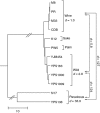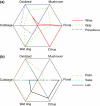Divergence in wine characteristics produced by wild and domesticated strains of Saccharomyces cerevisiae
- PMID: 22093681
- PMCID: PMC3262967
- DOI: 10.1111/j.1567-1364.2011.00746.x
Divergence in wine characteristics produced by wild and domesticated strains of Saccharomyces cerevisiae
Abstract
The budding yeast Saccharomyces cerevisiae is the primary species used by wine makers to convert sugar into alcohol during wine fermentation. Saccharomyces cerevisiae is found in vineyards, but is also found in association with oak trees and other natural sources. Although wild strains of S. cerevisiae as well as other Saccharomyces species are also capable of wine fermentation, a genetically distinct group of S. cerevisiae strains is primarily used to produce wine, consistent with the idea that wine making strains have been domesticated for wine production. In this study, we demonstrate that humans can distinguish between wines produced using wine strains and wild strains of S. cerevisiae as well as its sibling species, Saccharomyces paradoxus. Wine strains produced wine with fruity and floral characteristics, whereas wild strains produced wine with earthy and sulfurous characteristics. The differences that we observe between wine and wild strains provides further evidence that wine strains have evolved phenotypes that are distinct from their wild ancestors and relevant to their use in wine production.
© 2011 Federation of European Microbiological Societies. Published by Blackwell Publishing Ltd. All rights reserved.
Figures



References
-
- Barbosa C, Falco V, Mendes-Faia A, Mendes-Ferreira A. Nitrogen addition influences formation of aroma compounds, volatile acidity and ethanol in nitrogen deficient media fermented by Saccharomyces cerevisiae wine strains. J Biosci Bioeng. 2009;108:99–104. - PubMed
-
- Bisson LF, Karpel JE. Genetics of yeast impacting wine quality. Ann Rev Food Sci Technol. 2010;1:139–162. - PubMed
-
- Borneman AR, Forgan AH, Pretorius IS, Chambers PJ. Comparative genome analysis of Saccharomyces cerevisiae wine strain. FEMS Yeast Res. 2008;8:1185–1195. - PubMed
-
- Callejon R, Clavijo A, Ortigueira P, Troncoso AM, Paneque P, Morales ML. Volatile and sensory profile of organic red wines produced by different selected autochthonous and commercial Saccharomyces cerevisiae strains. Anal Chim Acta. 2010;660:68–75. - PubMed
-
- Carrau FM, Medina K, Farina L, Boido E, Henschke P, Dellacassa E. Production of fermentation aroma compounds by Saccharomyces cerevisiae wine yeasts: effects of yeast assimilable nitrogen on two model strains. FEMS Yeast Res. 2008;8:1196–1207. - PubMed
MeSH terms
Grants and funding
LinkOut - more resources
Full Text Sources
Molecular Biology Databases

